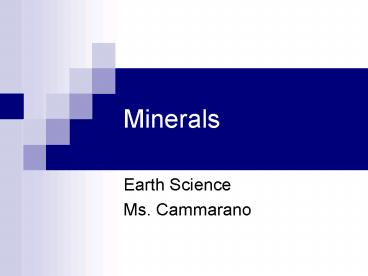Minerals - PowerPoint PPT Presentation
1 / 33
Title:
Minerals
Description:
Topaz. December. Turquoise. Mineral or Not? 1. Gold. 2. Diamond. 3. Quartz. 4. Oil. 5. Dinosaur Bone ... Silicates: Are the most common type of rock forming minerals. ... – PowerPoint PPT presentation
Number of Views:1165
Avg rating:3.0/5.0
Title: Minerals
1
Minerals
- Earth Science
- Ms. Cammarano
2
January
- Garnet
3
February
- Amethyst
4
March
- Aquamarine
5
April
- Diamond
6
May
- Emerald
7
June
- Pearl
8
July
- Ruby
9
August
- Peridot
10
September
- Sapphire
11
October
- Opal
12
November
- Topaz
13
December
- Turquoise
14
Mineral or Not?
- 1. Gold
- 2. Diamond
- 3. Quartz
- 4. Oil
- 5. Dinosaur Bone
- 6. Cotton
- 7. Talc
- 8. Nylon
- 9. Brass
15
What makes a Substance a Mineral?
- All Minerals Must
- 1) Be Naturally Occurring
- 2) Be a Solid
- 3) Be Inorganic (not living)
- 4) Have a Definite Chemical Composition
- 5) Have a molecular structure
16
The Two Most Abundant Elements in the Earths
Crust
- ESRT!
- Oxygen and Silicon (SiO)
- Silicates Are the most common type of rock
forming minerals. They are composed of the
elements silicon and oxygen.
17
Silicate Minerals
- Silicates SiO
- Talc
- Mica (Muscovite, Biotite)
- Pyroxene
- Amphiboles
- Feldspar (Potassium, Sodium)
- Olivine
- Quartz
- Garnet
- Each silicate has a structural unit called
- Silicate tetrahedron
18
Silicate Tetrahedron
- A triangle shape of atoms
- 4 oxygen atoms and 1 silicon atom
- Different arrangements of the tetrahedra in the
silicate group results in differences in the
minerals physical properties (hardness, color,
size)
19
Physical Properties of Minerals
- Physical Properties of Minerals result from their
INTERNAL ARRANGEMENT OF ATOMS
20
Minerals in Common Substances
- ESRT!
21
Specific Characteristics
- Specific Characteristics- Physical Properties.
- The physical properties of minerals are
determined by the internal arrangement of atoms.
22
Streak
- A mineral in its powder form.
- The color of the minerals streak may be
different from the color of the mineral.
23
Hardness
- The resistance to being scratched.
- Use Mohs Scale of Hardness
- Use a glass plate
- Glass has a hardness of 5.5
- If the mineral scratches glass it is harder than
glass
24
Luster
- The way in which light is reflected from the
surface of the mineral. - Metallic- mineral shines like polished metal
- Nonmetallic- no shine
25
Color
- The actual color of a mineral
- Color IS NOT a reliable identification alone!
Many different minerals have the same color!
26
Cleavage
- The tendency of a mineral to spilt along one or
more smooth, flat surfaces, or planes. - Mica- splits into thin flat sheets
27
Fracture
- The opposite of cleavage
- An uneven break of a mineral. Leaves a rough feel
28
Reaction to Chemicals
- Calcite fizzles when it comes in contact with HCL
29
Chemical Composition
- The elements that make up a mineral
- Most common elements
- Oxygen
- Silicon
30
Tetrahedron!
31
Monomineralic
- Contains ONE element
- Can you find any monomineralic minerals
- Graphite- Carbon- C
- Sulfur- S
32
Polymineralic
- Contains two or more minerals
- Can you name any polymineralic minerals?
- Galena- PbS (lead and sulfur)
33
(No Transcript)































